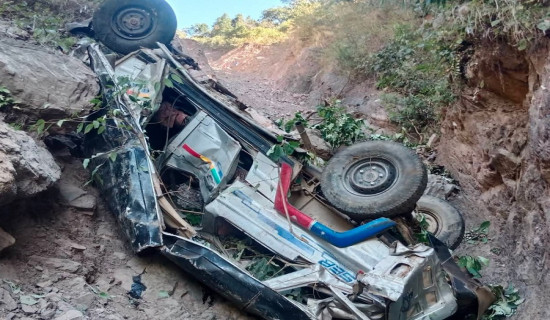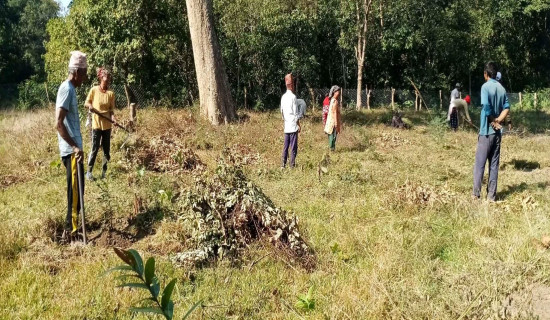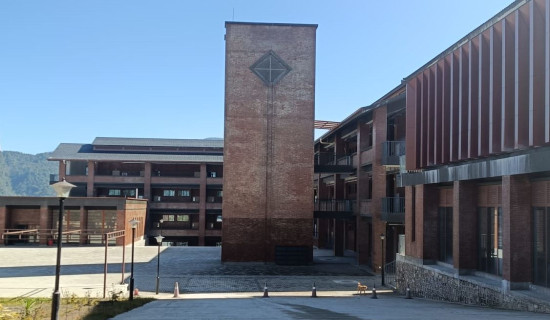- Sunday, 14 December 2025
Status Of Swamp Deer In Shuklaphanta
Shuklaphanta National Park is famous for its grasslands near Mahendranagar in Kanchanpur district of Nepal, in the far west of Nepal. This national park was established and protected as a hunting reserve in 2026. In the course of conservation, in 2032 BS, Shuklaphanta has declared a wildlife reserve covering an area of 155 square kilometres. In the year 2036, the area of 150 square kilometers on the east side of the National Park was expanded to 305 square kilometers. The previous boundary was announced as Shuklaphanta National Park in 2073, by publishing a notice in the Nepal Gazette. It is located at a height of 174 to 1386 meters.
The main grassland, called Shuklafanta, is the largest patch of continuous grassland in Nepal, covering an area of about 6.2 square miles. A large number of swamp deer can be seen in this national park.
Swamp deer is locally known as Bahrasinga (Rucervus duvaucelii). A male swamp deer has twelve horns when combined, for this reason, it is called Bharsinga which means 12 antlers. But it has up to 20 horns. These animals are found in Nepal, India, and Pakistan. But it is almost extinct in Pakistan. This animal is found in Shuklaphanta National Park and Bardia National Park in Nepal.
Characteristics
Male swamp deer are gray in winter and red and brown in summer. Female swamp deer are paler in color than males. Its tail is short, measuring only 12 to 20 cm, and its ears are round. An adult swamp deer is 180 to 190 cm in length. The height of the male is 120 to 135 cm, while the height of the female is 115 cm. The weight of the male animal is 170 to 200 kg, and the weight of the female is 140 to 145 kg. The head of a swamp deer is large, the hooves are spread out, and the neck of this animal is long. This animal's strong sense of smell helps it avoid predators. Swamp deer have a very loud vocalisation, which they use to signal danger. Predatory animals like tigers and leopards prey on swamp deer.
Distribution and habitat
Three subspecies of this deer species are found in Nepal and India. Western swamp deer are found in the plains of the Ganges and Nepal. The Southern Reindeer found in Madhya Pradesh, India, is the second subspecies and the third one is the Eastern Swamp Deer, which is protected in the Indian state of Assam.
Swamp deer is an antelope that is becoming rare. If this deer is not protected in time in Nepal, there is a threat of an extinction.
They like to live in herds of 20 to 60. There are more females than males in each herd. Swamp deer are pure herbivores. They eat the leaves of trees and grasses. They mostly graze in the morning and evening, resting during the hottest hours. There are large groups in the winter, but in the summer, they break up into smaller herds consisting mainly of females and their young ones. During this time, the males live separately from females in small groups.
Swamp deer is a very timid and nervous animal, sensitive to disturbance and easily frightened. They face many predators in the forest, including tigers and leopards.
Swamp deer prefer to live in swampy areas and grasslands. Its habitat altitude ranges from 100 to 300 meters above sea level.
During the breeding season, swamp deer form large herds of adults. The breeding season is from September to April, and after a gestation period of 240 to 250 days, the babies are born from August to November. Every year, 20 to 45 babies are born from 100 females. Its natural life span is 23 years.
Male swamp deer, like other species of antelope, also break their antlers when competing with another male for the right to mate with females.
Population
According to conservationists, the number of swamp deer in the area is increasing after the expansion of the swamp deer habitat in Shuklaphanta National Park.
The main habitat of this animal is the 55 square kilometers of grassland in the national park.
According to Manoj Aair, Information Officer of Shuklaphanta National Park, the number of swamp deer in 2021 was 2280, and in 2022 its population increased to 2313.
According to Ashish Neupane, Assistant Conservation Officer of Bardia National Park, the number of swamp deer before 2017 was 115. In 2017, the number of swamp deer decreased to 79.
This animal is listed as a vulnerable species in the IUCN Red List category and Appendix 1 of CITIES. It is classified as an endangered species by the National Red List of Mammals. The legal status of this species in Nepal is Appendix 10 under the National Parks and Wildlife Conservation Act, 1973.
Threats
It has been given a protected status due to its heavy habitat loss and the threat of poaching. This animal is hunted and traded in the national and international markets for its meat, horn and skin. Confined to Shuklaphanta National Park and Bardia National Park, the species is facing threats due to a lack of biological pathways connecting the areas. For the conservation of swamp deer, strict enforcement of conservation laws within protected areas and buffer zones, prohibition of domesticated cattle in its habitat, habitat improvement, and international anti-trade cooperation is essential.
Scientists say that thousands of swamp deer lived in the major rivers of India in the nineteenth century. Currently, most of the swamp deer are found in protected reserves such as Shuklaphanta National Park, Bardia National Park of Nepal and Dudhwa National Park in northern India, and Kanha National Park in central India.
In The Second Jungle Book, Rudyard Kipling depicts a swamp deer named Barasingha in the chapter ‘The Miracles of Purun Bhagat’. It befriends Purun Bhagat as the man wipes the deer's velvet from his horns. Then Puran Bhagat gives Swamp Deer Nights his warm fire and some fresh chestnuts from time to time at the shrine where he lives.
According to the National Parks and Wildlife Protection Act of 2029 BS, it is a protected species. According to sub-section (1) of the Act, those who kill or injure it can be punished with a fine of Rs. 100,000 to 500,000 and imprisonment of one year to ten years, or both. A reward of up to Rs. 25,000 has also been provided to the person who informs about the person who kills or injures swamp deer.
(The author is a wildlife photographer. Photos used in this article are by the author himself.)

















